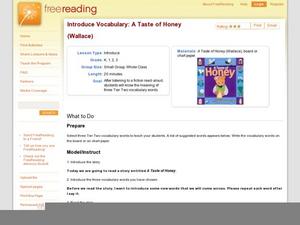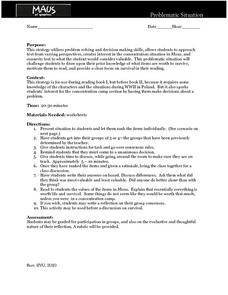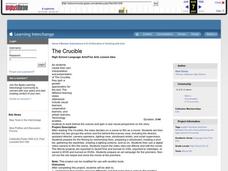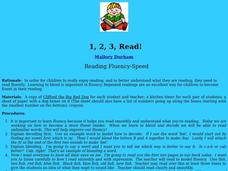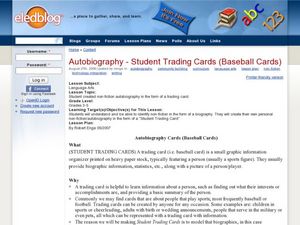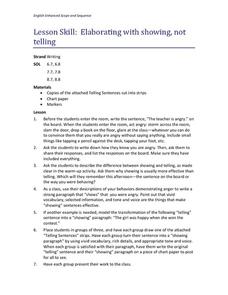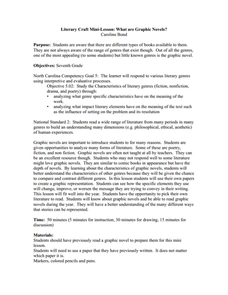Curated OER
Identifying Author’s Purpose and Viewpoint in Nonfiction Text
Why do people write books? Pupils discover how to identify the author's viewpoint. They read non-fiction passages their instructor selects (the plan has the class look at nonfiction children's picture books), and then identify the...
Curated OER
Three-Meal Weather: Food inspired adjectives from "Cloudy with a Chance of Meatballs"
Students complete a list of food adjectives based on the book Cloudy With A Chance of Meatballs. In this adjectives lesson plan, students also compose a 3 part piece of writing based on an entire day of raining food.
Curated OER
Where the Red Ferns
Where the Red Fern Grows provides the text for a study of the literary elements of plot, character, and setting. Discussion questions and vocabulary lists are referenced but not included.
Curated OER
Mark Twain and Huckleberry Finn Introductory Lessons
“What is the role or function of controversial art? And, should children, our children, be required—forced—to study certain works they may find painful or humiliating or offensive?” Robert Zalisk’s question, found in his article, “Uproar...
Curated OER
Introduce Vocabulary: A Taste of Honey (Wallace)
A Taste of Honey offers learners a chance to practice with unknown words and context clues. Choose several vocabulary words to focus on as you read the picture book, or use the ones provided here. Pre-teach the words and have scholars...
Curated OER
Maus I and II: Pictionary
Why is visual literacy so important in understanding Maus? Introduce your class to basic elements of graphic novels with a game of pictionary. A list of 13 words are included, but you could potentially add some World War II-related terms...
Curated OER
Maus: Problematic Situation Strategy
Do people really need “a newer, bigger Holocaust” in order to change? Or is it possible that by making text-to-self connections to the stories of others people that they can change? In order to connect to Art Spiegelman’s Maus, class...
Curated OER
The Diary of Anne Frank: Review/Discussion
Explore the hopeful and tragic world of Anne Frank and her family in this presentation. A background to Hitler's rise to power and the writing of The Diary of Anne Frank is given. Additionally, the slides include discussion questions...
Curated OER
The Crucible
Learners create a movie of a scene from The Crucible upon completion of reading the book. They assume a variety of roles in the film production.
Curated OER
Who's in the Shed?
Second graders examine the cover of the book, WHO'S IN THE SHED? and talk about the animals portrayed and the noises they make. They then read the book as a class, looking through the peepholes and making predictions.
Curated OER
1, 2, 3, Read!
Explain to your readers a variety of decoding strategies to improve their reading fluency. They observe the teacher modeling blending, then in pairs take turns reading the book Clifford the Big Red Dog. Learners then time each other...
Curated OER
Signal Words
What is a signal word, and why is it important? Since signal words are so important in a text, provide your learners with the list provided here. There are also three sample exercises provided here; they focus on the signal words but,...
Curated OER
Holes: Setting and Inferences
Learners read the book Holes, and draw a picture of the setting and answer questions about inferences regarding the book. They answer two questions and draw one setting.
Curated OER
Introduce Vocabulary: Clap Your Hands
Read Clap Your Hands to explore new vocabulary with your class. In this three-tiered vocabulary lesson, youngsters read the book and identify the plot, setting, and characters. They also define vocabulary terms from the book and answer...
Curated OER
Autobiography - Student Trading Cards
Motivate your class with this lesson! Learners use the trading card format to create an autobiography. They are given a list of characteristics to list, write down what they would like to include on their trading card, and head to the...
Curated OER
Understanding a Narrative: The True Story of Balto
Strong comprehension questions and a list of initiating events that drive the plot make this resource worth a try in your classroom. Intended for use with tools specific to the mindwing concepts reading strategy system, the outline...
Study Champs
Nouns
Plural, proper, and common nouns are all included here. After reviewing the definition of a noun and reading an example sentence, learners underline the nouns in each of 15 sentences. Each sentence lists how many nouns are present, so...
Curated OER
Story Map for Bud, Not Buddy
Why should your class complete a story map? After reading Bud, Not Buddy, divide your class into pairs or small groups to complete the included worksheet. They list the main characters, the conflict, main plot events, the resolution, and...
Curated OER
Walk Two Moons: DR-TA, Chapter 17: “In the Course of a Lifetime”
Use this question and answer activity as an assignment for Sharon Creech's Walk Two Moons. The questions listed support better comprehension and critical thinking of chapter seventeen.
Virginia Department of Education
Elaborating with Showing, Not Telling
This engaging activity is a great change of pace for the classroom. The activity starts with a simple message on the board “The teacher is angry.” The instructor is to stomp around, drop books and glare—anything to show anger. The...
Appalachian State University
What Are Graphic Novels?
To do this engaging and pleasurable activity, your learners should have already read a graphic novel, and produced a piece of writing that can be reproduced into the format of a graphic novel. This exercise provides a script that...
Education Center
Safety Sequence
Follow up a class reading of the children's book Officer Buckle and Gloria with this simple sequence-of-events learning exercise. Including pictures of six key moments from the story, young learners must first number them in the correct...
Learning Links
The Josefina Story Quilt Study Guide
Considering using The Josefina Story Quilt in your classroom? Check out this sample teaching guide for a list of pre-reading activities.
Curated OER
Help Me Learn About the Holocaust
Young readers select a book from a provided list to use as the basis for an intensive class study of Holocaust novels. After completing their novels, groups create a multimedia presentation highlighting the elements of literature...






